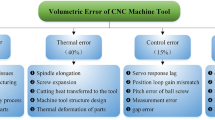Abstract
This paper presents a parametric approach to updating workpiece surfaces in a virtual environment. The workpiece surfaces are represented by a series of discrete vectors, which may be orientated in different directions. The methodology is developed for multi-axis machining in which a tool can be arbitrarily oriented in space. The cutter is modeled as a surface of revolution, which is a canal surface formed by sweeping a sphere with varying radius along a spine curve. To define the tool swept envelope, the cutter surfaces are decomposed into a set of characteristic circles which are generated by a two-parameter family of spheres. Then, the grazing points, at which the discrete vectors can intersect the tool envelope, are obtained by considering the relationships between these circles and feed vector of the cutter. From this, the envelope-vector intersections are transformed into a single-variable function. Examples of this technique are generated for typical milling tools with both linear and circular spine curves. The vector/tool envelope intersection calculations for cutters with linear spine curves can be performed analytically. However, the intersection calculations for cutters having circular spine curves require solving a system of nonlinear equations. For this purpose, a root-finding analysis is developed for guaranteeing the root(s) in the given interval. Finally, to improve the efficiency when updating the workpiece, a vector localization scheme is developed based on the Axis-aligned Bounding Box method.
Similar content being viewed by others
References
Voelcker H. B, Hunt W. A. Role of solid modeling in machining-process modeling and NC verification. SAE Preprints 1981; n: 810195, 10p.
Wang WP (1988) Solid modeling for optimizing metal removal of three-dimensional NC end milling. J Manuf Syst 7(1):57–65
Spence AD, Altintas YA (1994) Solid modeler-based milling process simulation and planning system. J of Eng for Ind, Transactions of the ASME 116(1):61–69
El Mounayri H, Spence AD, Elbestawi MA (1998) Milling process simulation—a generic solid modeler based paradigm. Journal of Manufacturing Science and Engineering, Transactions of the ASME 120(2):213–221
Gupta SK, Saini SK, Brent WS, Yao Z (2005) Geometric algorithms for computing cutter engagement functions in 2.5D milling operations. Comput-Aided Des 37:1469–1480
Yip-Hoi D, Huang X (2006) Cutter/Workpiece engagement feature extraction from solid models for end milling. Journal of Manufacturing Science and Engineering, Transactions of the ASME 128(1):249–260
Aras E, Yip-Hoi D. (2008) Geometric Modeling of Cutter/Workpiece engagements in three-axis milling using polyhedral representations. Journal of Computing and Information Science in Engineering, Transactions of the ASME 8(3).
Jerard RB, Drysdale RL, Hauck KE, Schaudt B, Magewick J (1989) Methods for detecting errors in numerically controlled machining of sculptured surfaces. Computer Graphics and Applications, IEEE 9(1):26–39
Chappel IT (1983) The use of vectors to simulate material removed by numerically controlled milling. Comput-Aided Des 15(3):156–158
Oliver JH, Goodman ED (1986) Color graphic verification of N/C milling programs for sculptured surface parts. First Symposium on Integrated Intelligent Manufacturing ASME
Wang WP, Wang KK (1986) Real-time verification of multi-axis NC programs with raster graphics. IEEE Proc. Int'l Conf. Robotics and Automation, CS Press; 166-171.
Wang WP, Wang KK (1986) Geometric modeling for swept volume of moving solids. CG&A 6(12):8–17
Van Hook T (1986) Real-time shaded NC milling display. Computer Graphics (Proc SIGGRAPH) 20(4):15–20
Atherton P, Earl C, Fred C. (1987) A graphical simulation system for dynamic five-axis NC verification. Proc. Auto fact. SME (2-1 to 2-12).
Choi B.K., Jerard R.B. (1998). Sculptured surface machining: Theory and Applications. Kluwer Academic Publishers
Fussel BK, Jerard RB, Hemmet JG (2003) Modeling of cutting geometry and forces for 5-axis sculptured surface machining. Comput-Aided Des 35:333–346
Chung YC, Park JW, Shin H, Choi BK (1998) Modeling the surface swept by a generalized cutter for NC verification. Comput-Aided Des 30(8):587–594
Baek N, Maeng SR, Shin SY, Choi BK (2003) A Z-map update method for linearly moving tools. Comput-Aided Des 35:995–1009
Baek N, Maeng SR, Shin SY, Choi BK (2004) A fast NC simulation method for circularly moving tools in the Z-map environment. Proceeding of the Geometric Modeling and Processing
Jerard RB, Hussaini SZ, Drysdale RL, Schaudt B (1989) "Approximate Methods for Simulation and Verification of Numerically Controlled Machining Programs", The Visual Computer, vol. 5, no. 6
Drysdale RL, Jerard RB, Schaudt B, Hauck K (1989) Discrete simulation of NC machining. Algorithmica Special Issue on Computational Geometry 4(1):33–60
Quinn J (1993) Accurate verification of five-axis numerically controlled machining. PhD Thesis, Department of Computer Science, Dartmouth College, Tech Report PCS-TR93-191
Chen CZ, Dong Z, Vickers WG (2003) Automated surface subdivision and toolpath generation for 3½½ axis CNC machining of sculptured parts. Computers in Industry 50:319–331
Peternell M, Pottmann H (1997) Computing rational parameterizations of canal surfaces. Journal of Symbolic Computation 23:255–266
Aras E (2009) Generating cutter swept envelopes in five-axis milling by two-parameter families of spheres. Comput-Aided Des 41(2):95–105
Frey DD, Otto KN, Pflager W (1997) Swept envelopes of cutting tools in integrated machine and workpiece error budgeting. Ann CIRP 46(1):475–480
Wang WP, Wang KK (1986) Geometric modeling for swept volume of moving solids. IEEE Comput Graph Appl 6(12):8–17
Blackmore D, Leu MC, Wang LP (1997) The sweep-envelope differential equation algorithm and its application to NC-machining verification. Comput-Aided Des 29(9):629–637
William HP, Saul AT, William TV, Brian PF (2007) Numerical Recipes 3rd Edn. The Art of Scientific Computing
Jung WP, Yang HS, Yun CC (2005) Hybrid cutting simulation via discrete vector model. Comput-Aided Des 37:419–430
You CF, Chu CH (1997) Toolpath verification in five-axis machining of sculptured surfaces. Int J Adv Manuf Technol 13(4):248–255
Ericson C (2005) Real-time collision detection. The Morgan Kaufmann Series in Interactive 3-D Technology
Author information
Authors and Affiliations
Corresponding author
Rights and permissions
About this article
Cite this article
Aras, E., Feng, HY. Vector model-based workpiece update in multi-axis milling by moving surface of revolution. Int J Adv Manuf Technol 52, 913–927 (2011). https://doi.org/10.1007/s00170-010-2799-8
Received:
Accepted:
Published:
Issue Date:
DOI: https://doi.org/10.1007/s00170-010-2799-8




